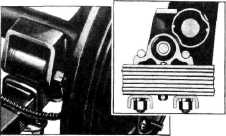1942 - 1947 CHEVROLET SHOP MANUAL
Section 4 - Rear Axle, Universal Joints & Springs
|
|
|||
|
4-36 |
|||
|
|
|||
|
Removal
1. Raise the car with a chain hoist and
disconnect the spring from the
hanger and spring seat.
2. Drill a 3/16" hole through the four rivets
which attach the hanger to the frame. Enlarge this hole with a 5/16" drill for depth of the
rivet head only. Cut off the
remainder of the rivet head
with a cold chisel.
3. Remove the hanger, then cut off the rivets
flush with the underside of
the frame side rail. (Do not
attempt to drive out the rivets without cutting them off or the hole
in the bottom plate of the side rail may be
distorted.)
4. Drive out the remaining portion of the
rivet.
Replacement
There are
right and left hangers which may be identified as follows: The spring eye
portion of the hanger is closer to one side than the other, Fig.
68. The hanger must be assembled to the side rail with the side containing
the spring eye toward the outside, as
shown in Fig. 68. Bolt the hanger to the side rail, using the following parts: Part
No. 369627
4 Special
Heat-Treated Bolts 5/16-18x1-1/8" Part No. 121367
4 Lockwashers
5/16"
Part No. 120376
4 Hex Nuts
5/16"-18
After the
bolts are drawn up tight, peen over the end to prevent the nut loosening
up.
PLAIN BUSHED SHACKLE
This type
of shackle is used at the rear of the rear springs on all 3/4, and
1-1/2-ton trucks. It consists of a heavy malleable shackle bushed at
the upper end to serve as a
bearing for the upper shackle
pin which passes through the shackle and the spring hanger, and a
lower shackle pin which passes through
the shackle and the spring eye
bushing. A "pinch" bolt at the spring hanger keeps the upper pin from
turning while the lower pin is anchored in the same way by the
"pinch" bolt at the
shackle.
The upper shackle pin may be
removed by first removing the "pinch"
bolt and then driving the pin
out from the inside, using a drift through the hole in the frame side rail for that
purpose. The shackle pin at the front of the rear spring may be
removed by driving the pin from the
spring eye bushing, through the
hole in the frame side rail, and into the "alligator jaw" of the frame
cross member.
The lower
shackle pin at the rear of the rear spring may be removed at the same time
the |
spring eye bushings are removed,
by disassembling the rear spring from
the spring shackle and pressing the pin from the spring eye on an arbor
press.
NOTE—On all 3/4-ton trucks the
rear springs are 2" wide, while on the 1-1/2-ton truck they are 2-1/2"
wide. In order to use the same shackle bracket on both trucks it is
necessary to use 1/2" spacers on all 3/4-ton models to fill this
space. These spacers are located on the inner side of the
spring.
SPRING COVERS
The rear
springs on all passenger cars are equipped with metal spring
cavers.
Should it ever become necessary to
replace the spring covers, a special service spring cover is used. These
covers are composed of several sections and can be clinched in place without removing
the springs or straightening
them out. Service spring covers
are stocked in the warehouses under two part numbers—603154 for
coupe and cabriolet only, and 603153 for all other models.
REAR SPRING
SEATS
Passenger Cars
The rear springs of all passenger
cars are completely insulated from the axle by the means of a rubber core. At each seat, a bracket is
welded on |
||
 |
|||
|
Fig. 69—Passenger Rear Spring Seat
the front side of the housing,
Fig. 69. An eye bolt passes through
this bracket and the spring seat in a manner similar to the way the front
end of the rear spring is mounted. A steel spacer sleeve is used to
prevent collapsing the walls of the axle bracket when the eye bolt and nut
are pulled down tight. Between the spacer sleeve and the spring seat is a
rubber bushing. Rubber washers at each end complete the insulation.
The mounting effectively dampens
out objectionable road noise at its source and, in doing so,
prevents it from telegraphing
through the springs and |
|||
|
|
|||